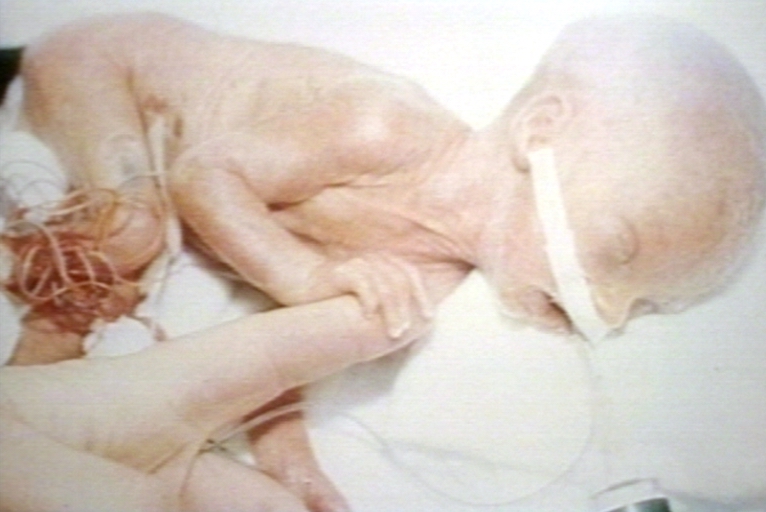Intrauterine growth retardation: Difference between revisions
| Line 195: | Line 195: | ||
* [[ Marden-Walker syndrome]] | * [[ Marden-Walker syndrome]] | ||
{{ColBreak}} | {{ColBreak}} | ||
* | * [[Maternal kidney failure]] | ||
* | * [[Maternal alcoholism ]] | ||
* | * [[Maternal anemia]] | ||
* | * [[Maternal smoking]] | ||
* | * [[Maternal collagen vascular disease]] | ||
* | * [[Maternal infection]] | ||
* | * [[Maternal kidney disease]] | ||
* | * [[ Maternal lung disease]] | ||
* | * [[ Maternal malnutrition]] | ||
* [[ Maturity onset diabetes of the young]] | * [[ Maturity onset diabetes of the young]] | ||
* [[ Meckel-Gruber syndrome]] | * [[ Meckel-Gruber syndrome]] | ||
Revision as of 14:17, 24 July 2012
| Intrauterine growth retardation | |
 | |
|---|---|
| A premature newborn Image courtesy of Professor Peter Anderson DVM PhD and published with permission © PEIR, University of Alabama at Birmingham, Department of Pathology | |
| MedlinePlus | 001500 |
For patient information, click here
Editor-In-Chief: C. Michael Gibson, M.S., M.D. [1]Associate Editor(s)-in-Chief: : Kalsang Dolma, M.B.B.S.[2]
Synonyms and keywords: Intrauterine growth restriction
Overview
Intrauterine growth retardation (IUGR) refers to poor growth of a baby while in the mother's womb during pregnancy.
Classification
Asymmetrical IUGR is more common. In asymmetrical IUGR, there is restriction of weight followed by length. The head continues to grow at normal or near-normal rates (head sparing). This is a protective mechanism that may have evolved to promote brain development. This type of IUGR is most commonly caused by extrinsic factors that affect the fetus at later gestational ages.
Symmetrical IUGR is less common and is more worrisome. This type of IUGR usually begins early in gestation. Since most neurons are developed by the 18th week of gestation, the fetus with symmetrical IUGR is more likely to have permanent neurological sequela
Pathophysiology
If the cause of IUGR is extrinsic to the fetus (maternal or uteroplacental), transfer of oxygen and nutrients to the fetus is decreased. This causes a reduction in the fetus’ stores of glycogen and lipids. This often leads to hypoglycemia at birth. Polycythemia can occur secondary to increased erythropoietin production caused by the chronic hypoxemia. Hypothermia, thrombocytopenia, leukopenia, hypocalcemia, and pulmonary hemorrhage are often results of IUGR.
If the cause of IUGR is intrinsic to the fetus, growth is restricted due to genetic factors or as a sequelae of infection.
Causes
Common Causes
Causes by Organ system
| Cardiovascular | No underlying causes |
| Chemical / poisoning | No underlying causes |
| Dermatologic | No underlying causes |
| Drug Side Effect | No underlying causes |
| Ear Nose Throat | No underlying causes |
| Endocrine | No underlying causes |
| Environmental | No underlying causes |
| Gastroenterologic | No underlying causes |
| Genetic | No underlying causes |
| Hematologic | No underlying causes |
| Iatrogenic | No underlying causes |
| Infectious Disease | No underlying causes |
| Musculoskeletal / Ortho | No underlying causes |
| Neurologic | No underlying causes |
| Nutritional / Metabolic | No underlying causes |
| Obstetric/Gynecologic | No underlying causes |
| Oncologic | No underlying causes |
| Opthalmologic | No underlying causes |
| Overdose / Toxicity | No underlying causes |
| Psychiatric | No underlying causes |
| Pulmonary | No underlying causes |
| Renal / Electrolyte | No underlying causes |
| Rheum / Immune / Allergy | No underlying causes |
| Sexual | No underlying causes |
| Trauma | No underlying causes |
| Urologic | No underlying causes |
| Miscellaneous | No underlying causes |
Causes by Alphabetical Order
Epidemiology and demographics
At least 60% of the 4 million neonatal deaths that occur worldwide every year are associated with low birth weight (LBW), caused by intrauterine growth restriction (IUGR), preterm delivery, and genetic/chromosomal abnormalities,[1] demonstrating that under-nutrition is already a leading health problem at birth.
Risk factors
Risk factors in the mother that may contribute to IUGR include:
- Alcohol abuse
- Clotting disorders
- Drug addiction
- High blood pressure or heart disease
- Kidney disease
- Poor nutrition
- Smoking
Natural history, Complications and Prognosis
- After delivery, growth and development of the newborn depends on the severity and cause of IUGR.
- Depending on the specific cause, IUGR increases the risk for a variety of pregnancy and newborn complications.
- Infants may have a non-reassuring fetal heart rate during labor, requiring delivery by c-section.
- Perinatal mortality rates are 4-8 times higher for infants with IUGR, and morbidity is present in 50% of surviving infants.
History and Symptoms
- A pregnant woman may feel that her baby is not as big as it should be.
Physical Examination
- Uterine fundal height: Smaller than expected for the baby's gestational age.
References
- ↑ Lawn 2005